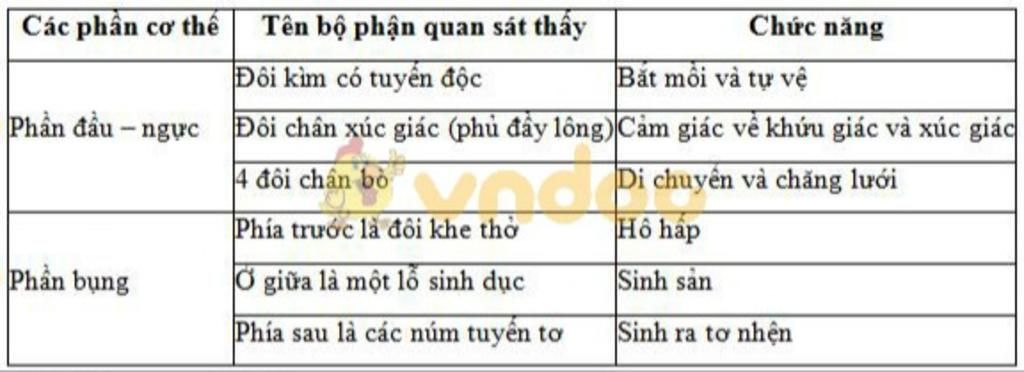Ai chép sinh bài 25 không lớp 7 ấy Lớp hình nhện Ai chép đầy đủ gửi mình với
2 câu trả lời
Đáp án+Giải thích các bước giải:
I. NHỆN
1. Đặc điểm cấu tạo
Cơ thể nhện gồm 2 phần: phần đầu – ngực và phần bụng
* Phần đầu – ngực gồm:
- Đôi kìm có tuyến độc: bắt mồi và tự vệ
- Đôi chân xúc giác: cảm giác về khứu giác và xúc giác
- 4 đôi chân bò: di chuyển và chăng lưới
* Phần bụng gồm:
- Đôi khe thở: hô hấp
- Lỗ sinh dục: sinh sản
- Các núm tuyến tơ: sinh ra tơ nhện
2. Tập tính
a. Tập tính chăng lưới: Thứ tự các bước của tập tính chăng lưới của nhện
1, Chăng dây tơ khung
2, Chăng dây tơ phóng xạ
3, Chăng sợi tơ vòng
4, Chờ mồi
b. Tập tính bắt mồi: Thứ tự như sau:
1, Nhện ngoặm chặt mồi, chích nọc độc
2, Tiết dịch tiêu hóa vào cơ thể mồi
3, Trói chặt mồi rồi treo vào lưới 1 thời gian
4, Nhện hút dịch lỏng ở con mồi
II. SỰ ĐA DẠNG CỦA LỚP HÌNH NHỆN
1. Một số đại diện
- Lớp hình nhện đa dạng về loài và phong phú về môi trường sống, tập tính sống.
- Một số đại diện lớp Hình nhện: bọ cạp, cái ghẻ, ve bò…
2. Ý nghĩa thực tiễn
- Đa số có lợi vì chúng bắt sâu bọ có hại: nhện, bọ cạp …
- Một số có hại, gây bệnh cho con người, động vật…: Cái ghẻ, ve bò…
⇒MONG ĐC HAY NHẤT Ạ^^
Đáp án:
I. NHỆN
Lớp hình nhện đã biết khoảng 36 nghìn loài là các chân khớp ở cạn đầu tiên. Chúng thích sống nơi hang hốc, rậm rạp và hoạt động chủ yếu về đêm
1. Đặc điểm cấu tạo của nhện
- Bảng đặc điểm cấu tạo ngoài của nhện
gửi ảnh
2. Tập tính
* Chăng lưới
Quá trình chăng lưới diễn ra như sau:
- Chăng dây tơ khung → Chăng dây tơ phóng xạ → Chăng các sợi tơ vòng → Chờ mồi
+ Các loài nhện có các kiểu mạng đa dạng, đặc trưng
* Bắt mồi
Khi con mồi sa lưới → Nhện ngoạm chặt mồi, chích nọc độc → Tiết dịch tiêu hóa vào cơ thể mồi → Trói chặt mồi rồi treo vào lưới để một thời gian → Nhện hút dịch lỏng ở con mồi.
II. SỰ ĐA DẠNG CỦA LỚP HÌNH NHỆN
1. Một số đại diện
→ Sự đa dạng hình nhện về số lượng loài, lối sống và cấu tạo cơ thể
2. Ý nghĩa thực tiễn
- Trừ một số đại diện (cái ghẻ, ve bò…) gây bệnh cho người và động vật còn đa số nhện đều có lợi vì chúng săn bắt sâu bọ có hại, làm thực phẩm…
- Biện pháp bảo vệ Hình nhện có lợi:
+ Nuôi để gia tăng số lượng, tạo điều kiện cho phát triển tốt
+ Khai thác hợp lí, tránh nguy cơ tuyệt chủng
+ Lai tạo giống mới
- Biện pháp tiêu diệt Hình nhện có hại:
+ Dùng thiên địch (bọ rùa)
+ Thuốc hóa học diệt trừ
+ Biện pháp thủ công: bắt và tiêu diệt


